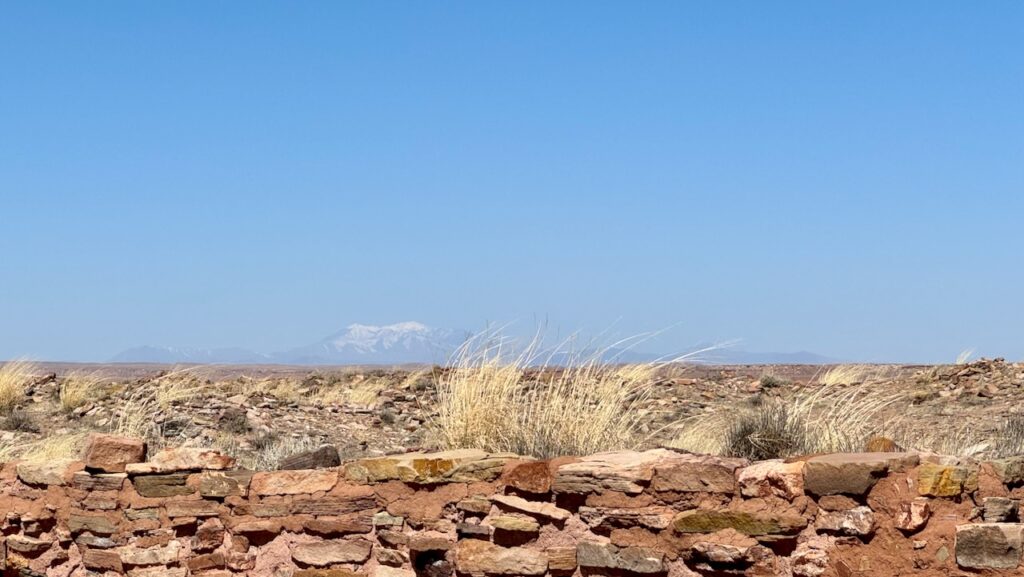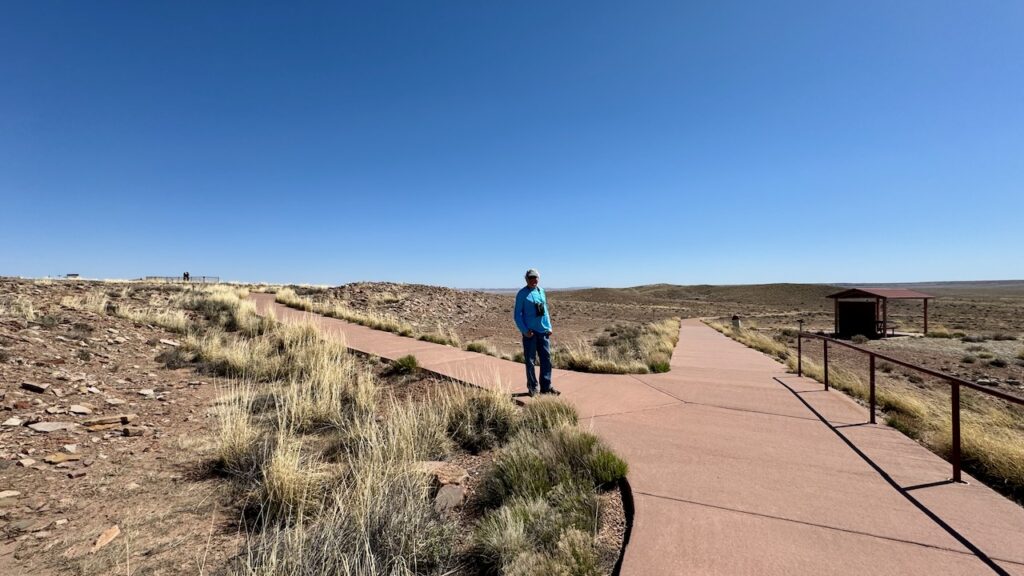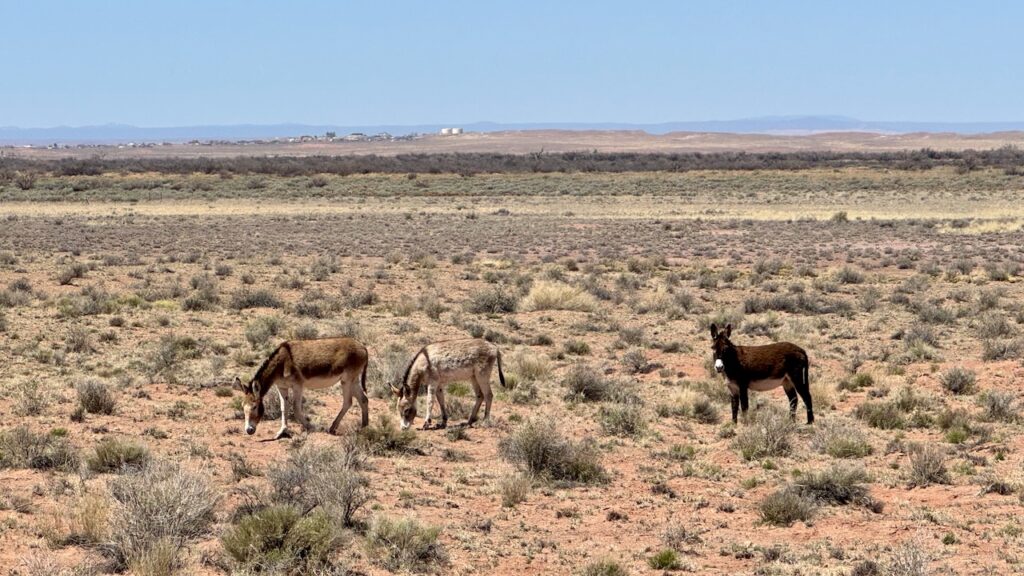Ruins, Donkeys, Cows, Birds and a Lizard
April 13, 2024 – Day 26
Homolovi State Park Campground, Winslow Arizona
Finally, we don’t have to drive today. Sure, we could have but the last 4 days have been a thrash. It was almost 1,400 miles in 4 days, the last two of which were very windy which is fatiguing when you’re driving an RV.
Taking a cue from that famous song we took it easy this morning. Later we went off to see the Homolovi II ruins. Somehow we didn’t see these when we were here last time. Neither of us can remember why but likely it was too hot for much outdoor activity.a
Around A.D. 1330, a group of people arrived from the Hopi Mesas, 60 miles north, drawn by the lush flood plain of the Little Colorado River. These people built a 1200 room village; 750 to 1000 people lived in this pueblo.
The people farmed in the flood plain and in the sand dunes.
They grew corn, beans, squash and cotton. They also gathered wild foods such as pigweed, Indian rice grass, cactus and yucca fruits, and piñon nuts. Cotton cloth was exchanged with the inhabitants of villages north and west.
Research and excavations by Arizona State Museum at Homol’ovi Il revealed three plazas, outdoor activity areas, possibly 40 kivas, and living, working, and storage areas.
Prior to A.D. 1400, the people of Homol’ovi Il, along with others, left the middle Little Colorado River valley. Hopi oral history and archaeological clues suggest that the people made their way back to their ancestral villages on the Hopi Mesas after leaving the Homol’ovi area.
Their descendants return periodically to gather wild resources and visit shrines.
There are 4 Homolovi sites, we had visited Homolovi I the last time we were here. In that park, all the kivas were buried. The archeologists had reburied them to protect them from the elements, theft and vandalism. This set of ruins had 2 that were exposed.

A typical room used for domestic activities would have slab-lined floor pits for cooking and heating similar to those found here in the West Plaza. Storage rooms lacked such floor features.
To the left of these five rooms is an area that was probably used to roast corn and small game. The back wall of the room directly in front of you contains a sealed doorway.

On the horizon are the highest mountains in Arizona, the San Francisco Peaks (12,670 feet). The Hopi call them Nuvatukya’ovi and believe they are the home of the Katsina spirits. Katsina are supernatural beings with the power to bring the rain needed to make crops grow and produce a bountiful harvest. They played an important role in the religious beliefs of the people who lived here.
Katsina ceremonies are still conducted in the village plazas on the Hopi Mesas.
Unlike Homolovi I, in this section you walked on a concrete path, in H1 you walked on the dirt, in and amongst the ruins. While this one was easier to walk the other one was more intimate.

In this next photo you aren’t seeing the buried rectangular wall that we saw in H1, rather, these are modern pits when “treasure hunters”, aka vandals and jerk-heads, dug up the sacred site.

This is a restored, vandalized, pit.

In the depression is a kiva. Kiva means “cellar” or “underground house”. Men are primary users of kivas; women and children have access during certain ceremonies and seasons.
This kiva is 14 by 17 feet and 6 feet deep. The floor and benches were paved with flagstones. Anchored to the roof and floor was a vertical loom for weaving cotton. At abandonment, many kivas were ritually closed. Air shafts and hearths were filled and sealed, and their roofs were burned.

Arizona State Parks preserved this vandalized kiva. It is the largest of the kivas in Homol’ovi Il and measures 19.7 by 32.8 feet and is 6.6 feet deep. The pit near the south end of the structure is a hearth, and the small stone wall deflects and circulates fresh air coming in from under the bench. The large pit at the north end of the kiva may represent a sipapu, symbolic of the hole of emergence.
This section of the park is also open range. We saw cows and donkeys!


We stopped a lot to look for birds. We saw 4 new life birds along the road and later at the Visitor’s Center. There was also this cool lizard that didn’t seem to care about us at all. It had very cute mannerisms. It would skedaddle 5 or so feet and then do “push ups” and run further in and out of the rock work.

Adventures complete, we went back to the RV and hung out for a bit before heading into town for dinner. There are an awful lot of Dennys and Taco Bell like restaurants here in Winslow so there wasn’t a wide variety of local fare to choose from. Last visit we had eaten at the RelicRoad Brewing Company and it was pretty good so we went there and were not disappointed. We saw a great sunset on the way back.

Life Birds: 4: Western Meadowlark, Black-throated Sparrow, Brewer’s Sparrow, & Horned Lark. Sadly, we never got close enough to the Horned Lark to see the cute “horns.” Next time!